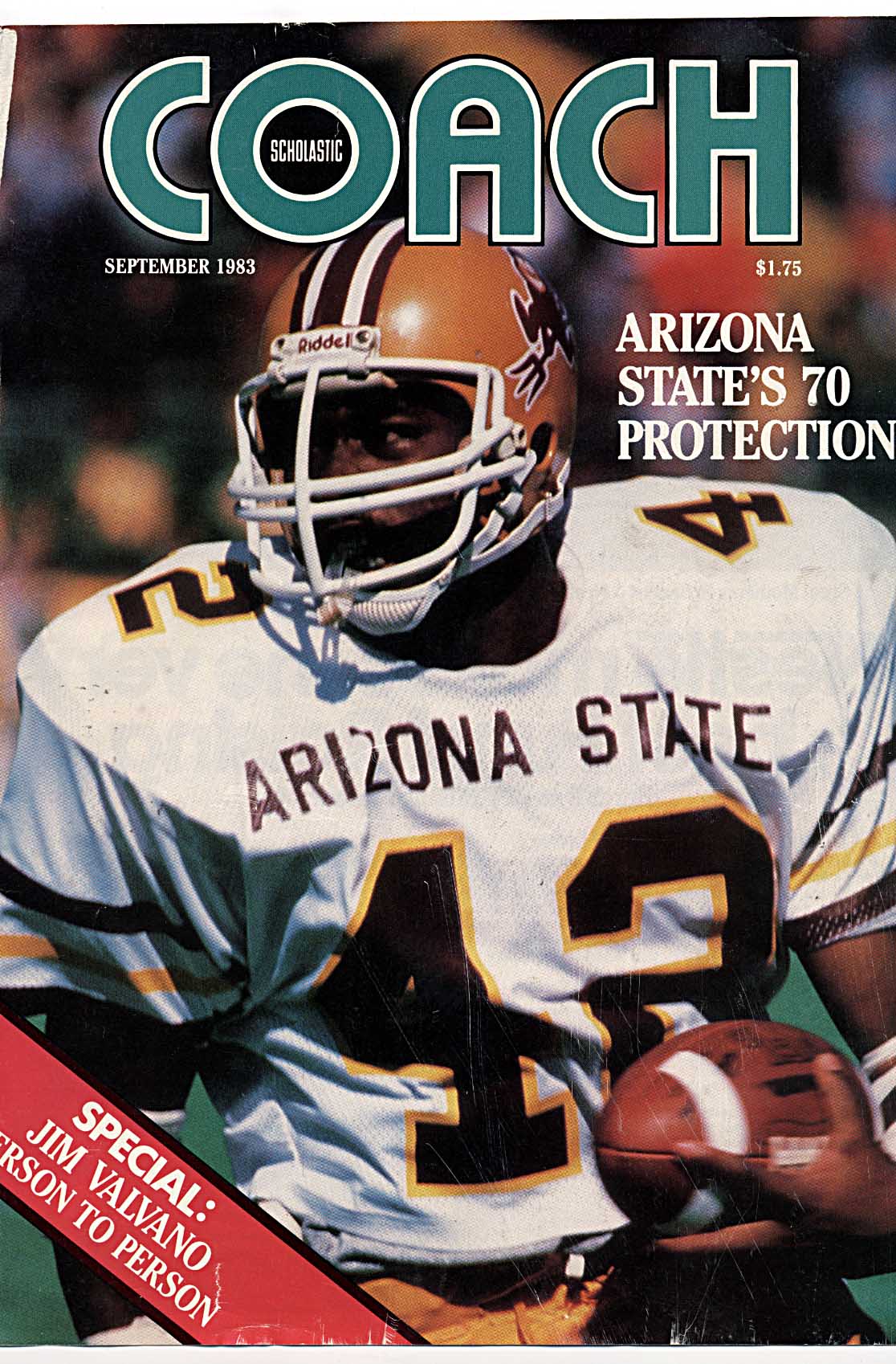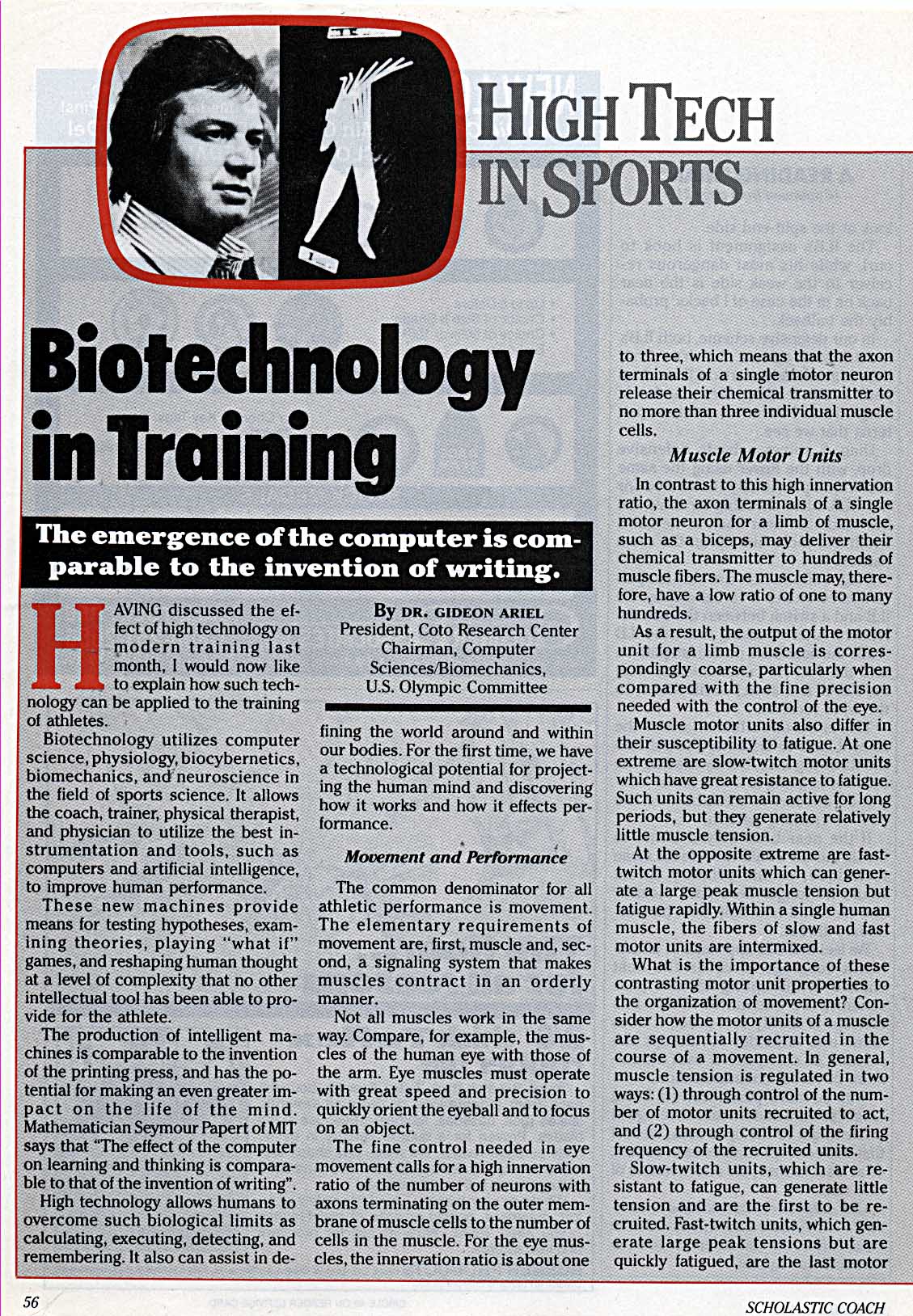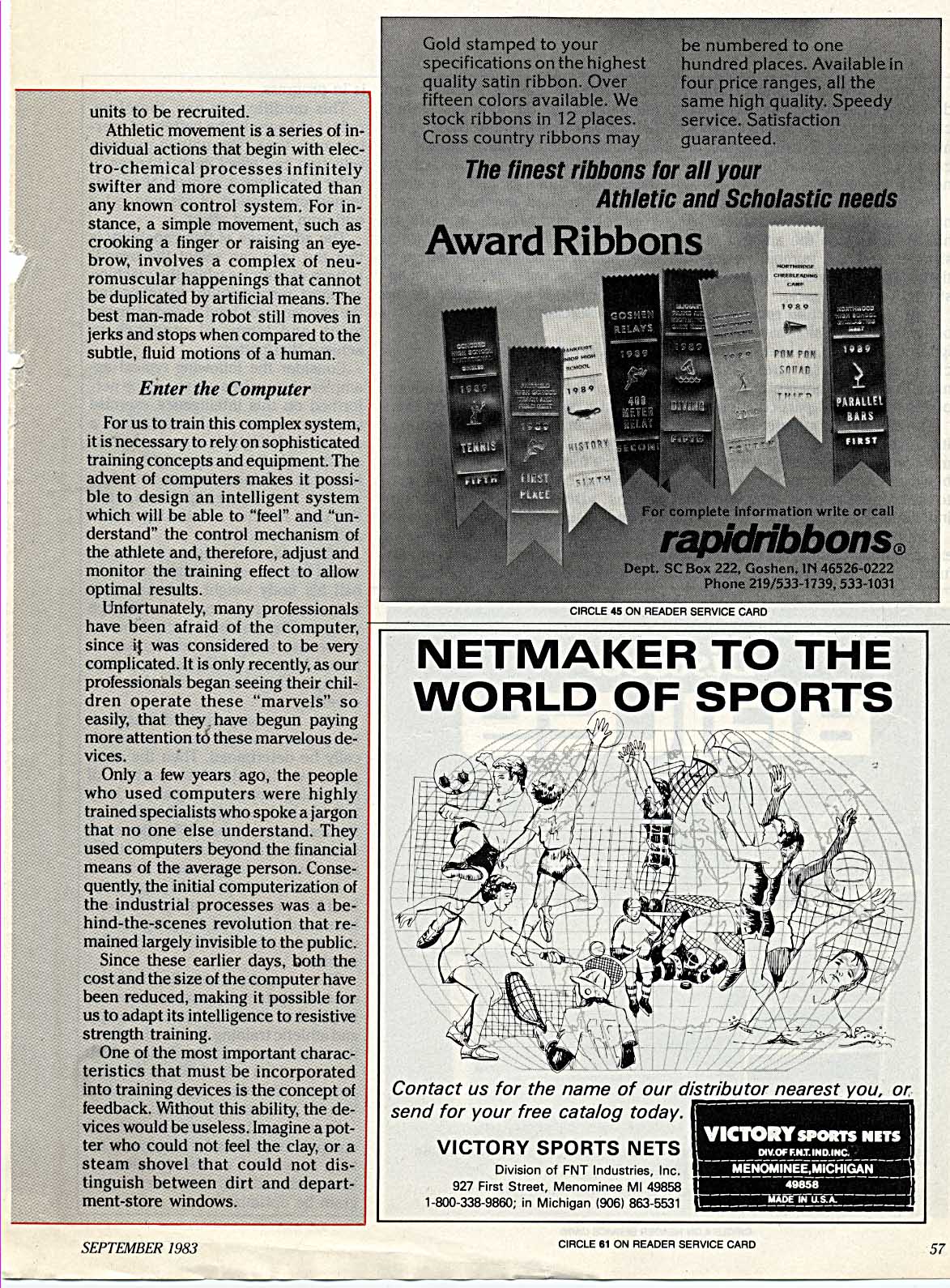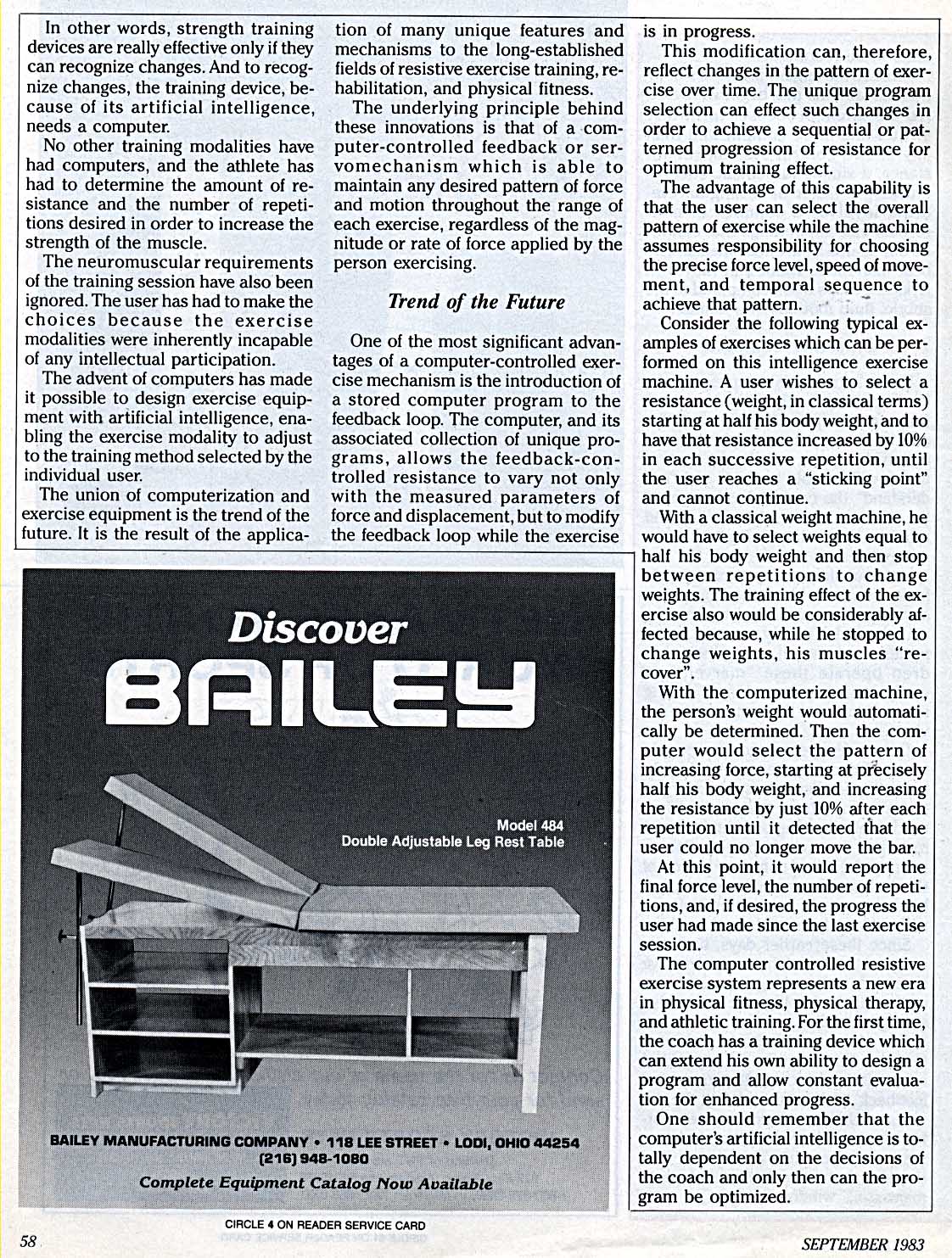Biotechnology in Training
Biotechnology utilizes computer science, physiology, biocybernetics, biomechanics, and neuroscience in the field of sports science
By Gideon Ariel in Scholastic Coach on Thursday, September 1, 1983
Biotechnology in Training
This article discusses the application of biotechnology in the training of athletes. Biotechnology uses computer science, physiology, biocybernetics, biomechanics, and neuroscience in sports science. It provides coaches, trainers, physical therapists, and physicians with advanced tools to improve human performance. The article also highlights the importance of movement in athletic performance and the role of muscle motor units in this process. It further explains how computers can be used to design intelligent systems that can understand and adjust the control mechanism of athletes for optimal results. The article concludes by stating that the integration of computerization and exercise equipment is the future trend in resistive exercise training, rehabilitation, and physical fitness.
Tip: use the left and right arrow keys
Biotechnology in Training
AVING discussed the effect of high technology on modern training last month, I would now like to explain how such tech
nology can be applied to the training of athletes.
Biotechnology utilizes computer science, physiology, biocybernetics, biomechanics, and neuroscience in the field of sports science. It allows the coach, trainer, physical therapist, and physician to utilize the best instrumentation and tools, such as computers and artificial intelligence, to improve human performance.
These new machines provide means for testing hypotheses, examining theories, playing "what if" games, and reshaping human thought at a level of complexity that no other intellectual tool has been able to provide for the athlete.
The production of intelligent machines is comparable to the invention of the printing press, and has the potential for making an even greater impact on the life of the mind. Mathematician Seymour Papert of MIT says that "The effect of the computer on learning and thinking is comparable to that of the invention of writing".
High technology allows humans to overcome such biological limits as calculating, executing, detecting, and remembering. It also can assist in de
fining the world around and within our bodies. For the first time, we have a technological potential for projecting the human mind and discovering how it works and how it effects performance.
Movement and Performance
The common denominator for all athletic performance is movement. The elementary requirements of movement are, first, muscle and, second, a signaling system that makes muscles contract in an orderly manner.
Not all muscles work in the same way. Compare, for example, the muscles of the human eye with those of the arm. Eye muscles must operate with great speed and precision to quickly orient the eyeball and to focus on an object.
The fine control needed in eye movement calls for a high innervation ratio of the number of neurons with axons terminating on the outer membrane of muscle cells to the number of cells in the muscle. For the eye muscles, the innervation ratio is about one
to three, which means that the axon terminals of a single motor neuron release their chemical transmitter to no more than three individual muscle cells.
Muscle Motor Units
In contrast to this high innervation ratio, the axon terminals of a single motor neuron for a limb of muscle, such as a biceps, may deliver their chemical transmitter to hundreds of muscle fibers. The muscle may, therefore, have a low ratio of one to many hundreds.
As a result, the output of the motor unit for a limb muscle is correspondingly coarse, particularly when compared with the fine precision needed with the control of the eye.
Muscle motor units also differ in their susceptibility to fatigue. At one extreme are slow-twitch motor units which have great resistance to fatigue. Such units can remain active for long periods, but they generate relatively little muscle tension.
At the opposite extreme are fasttwitch motor units which can generate a large peak muscle tension but fatigue rapidly. Within a single human muscle, the fibers of slow and fast motor units are intermixed.
What is the importance of these contrasting motor unit properties to the organization of movement? Consider how the motor units of a muscle are sequentially recruited in the course of a movement. In general, muscle tension is regulated in two ways: (1) through control of the number of motor units recruited to act, and (2) through control of the firing frequency of the recruited units.
Slow-twitch units, which are resistant to fatigue, can generate little tension and are the first to be recruited. Fast-twitch units, which generate large peak tensions but are quickly fatigued, are the last motor
By DR. GIDEON ARIEL
President, Coto Research CenterChairman, ComputerSciences/Biomechanics,U.S. Olympic Committee
56
SCHOLASTIC COACH
units to be recruited.
Athletic movement is a series of individual actions that begin with electrochemical processes infinitely swifter and more complicated than any known control system. For instance, a simple movement, such as crooking a finger or raising an eyebrow, involves a complex of neuromuscular happenings that cannot be duplicated by artificial means. The best man-made robot still moves in jerks and stops when compared to the subtle, fluid motions of a human.
Enter the Computer
For us to train this complex system, it is necessary to rely on sophisticated training concepts and equipment. The advent of computers makes it possible to design an intelligent system which will be able to "feel" and "understand" the control mechanism of the athlete and, therefore, adjust and monitor the training effect to allow optimal results.
Unfortunately, many professionals have been afraid of the computer, since it was considered to be very complicated. It is only recently, as our professionals began seeing their children operate these "marvels" so easily, that they, have begun paying more attention tO these marvelous devices.
Only a few years ago, the people who used computers were highly trained specialists who spoke a jargon that no one else understand. They used computers beyond the financial means of the average person. Consequently, the initial computerization of the industrial processes was a behind-the-scenes revolution that remained largely invisible to the public.
Since these earlier days, both the cost and the size of the computer have been reduced, making it possible for us to adapt its intelligence to resistive strength training.
One of the most important characteristics that must be incorporated into training devices is the concept of feedback. Without this ability, the devices would be useless. Imagine a potter who could not feel the clay, or a steam shovel that could not distinguish between dirt and department-store windows.
rapidribbonso
- SC Box 222, Goshen. IN 46526-0222 Phone 219/533-1739, 533-1031
Gold stamped to your
specifications on the highest quality satin ribbon. Over fifteen colors available. We stock ribbons in 12 places. Cross country ribbons may
be numbered to one hundred places. Available in four price ranges, all the same high' quality. Speedy service. Satisfaction guaranteed.
The finest ribbons for all your
Athletic and Scholastic needs
Award Ribbons
For complete information write or call
P:
CIRCLE 45 ON READER SERVICE CARD
NETMAKER TO THE
WORLD__ OF SPORTS
Contact us for the name of our distributor nearest you, send for your free catalog today.
VICTORY SPORTS NETS
Division of FNT Industries, Inc.
927 First Street, Menominee MI 49858
1-800-338-9860; in Michigan (906) 863-5531
VICTORY SPORTS NETS
_DIK_OFFILTMID.IN_C. -
MENOMINEE,MICHIGAN ---------------
SEPTEMBER 198.3
CIRCLE 61 ON READER SERVICE CARD
In other words, strength training devices are really effective only if they can recognize changes. And to recognize changes, the training device, because of its artificial intelligence, needs a computer.
No other training modalities have had computers, and the athlete has had to determine the amount of resistance and the number of repetitions desired in order to increase the strength of the muscle.
The neuromuscular requirements of the training session have also been ignored. The user has had to make the choices because the exercise modalities were inherently incapable of any intellectual participation.
The advent of computers has made it possible to design exercise equipment with artificial intelligence, enabling the exercise modality to adjust to the training method selected by the individual user.
The union of computerization and exercise equipment is the trend of the future. It is the result of the applica
tion of many unique features and mechanisms to the long-established fields of resistive exercise training, rehabilitation, and physical fitness.
The underlying principle behind these innovations is that of a computer-controlled feedback or servomechanism which is able to maintain any desired pattern of force and motion throughout the range of each exercise, regardless of the magnitude or rate of force applied by the person exercising.
Trend of the Future
One of the most significant advantages of a computer-controlled exercise mechanism is the introduction of a stored computer program to the feedback loop. The computer, and its associated collection of unique programs, allows the feedback-controlled resistance to vary not only with the measured parameters of force and displacement, but to modify the feedback loop while the exercise
is in progress.
This modification can, therefore, reflect changes in the pattern of exercise over time. The unique program selection can effect such changes in order to achieve a sequential or patterned progression of resistance for optimum training effect.
The advantage of this capability is that the user can select the overall pattern of exercise while the machine assumes responsibility for choosing the precise force level, speed of movement, and temporal sequence to achieve that pattern.
Consider the following typical examples of exercises which can be performed on this intelligence exercise machine. A user wishes to select a resistance (weight, in classical terms) starting at half his body weight, and to have that resistance increased by 10% in each successive repetition, until the user reaches a "sticking point" and cannot continue.
With a classical weight machine, he would have to select weights equal to half his body weight and then stop between repetitions to change weights. The training effect of the exercise also would be considerably affected because, while he stopped to change weights, his muscles "recover".
With the computerized machine, the person's weight would automatically be determined. Then the computer would select the pattern of increasing force, starting at precisely half his body weight, and increasing the resistance by just 10% after each repetition until it detected that the user could no longer move the bar.
At this point, it would report the final force level, the number of repetitions, and, if desired, the progress the user had made since the last exercise session.
The computer controlled resistive exercise system represents a new era in physical fitness, physical therapy, and athletic training. For the first time, the coach has a training device which can extend his own ability to design a program and allow constant evaluation for enhanced progress.
One should remember that the computer's artificial intelligence is totally dependent on the decisions of the coach and only then can the program be optimized.
BAILEY MANUFACTURING COMPANY � 118 LEE STREET � LOOT, OHIO 44254
(216) 946-1080
Complete Equipment Catalog Now Available
CIRCLE 4 ON READER SERVICE CARD
58
SEPTEMBER 1983




